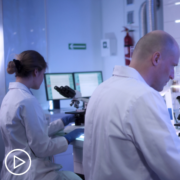What Are AML Inhibitor Therapies and How Do They Work?
What Are AML Inhibitor Therapies and How Do They Work? from Patient Empowerment Network on Vimeo.
What are AML inhibitor therapies, and how do they work? Dr. Gail Roboz explains the different types of inhibitor therapies, their targets, the patient type they may benefit most, and a new class of targeted treatments.
Related Resources:

|

Expert Overview | AML Treatment Options and Phases of Therapy |

|
Transcript:
Katherine Banwell:
You mentioned one inhibitor as targeted therapy, but there are a couple of others. Would you briefly tell us about those?
Dr. Gail Roboz:
So, over the years recently, we have identified certain specific targets in AML which are resulting in the addition of medications on these standard backbones. So, the target for venetoclax (Venclexta) is something called BCL2, and actually, venetoclax probably makes all chemotherapy better. It’s kind of a controversial statement, but I’m going to stand by it. But in AML, it has been shown that the addition of venetoclax to lots of different backbones makes them work better. There are other things to hit, though.
For example, there are patients with AML who have something called a FLT3, F-L-T-3 mutation. This mutation also has specific inhibitors that are FDA-approved drugs that target specifically the FLT3 mutation, and if you have one of those, your doctor may add on a FLT3 inhibitor to either a lower intensity or an intensive backbone. Similarly, there are agents called IDH inhibitors. There are IDH1 and IDH2 inhibitors.
If I start getting into isocitrate dehydrogenase pathways on this webinar, I think everybody will click off, because it’s certainly bored all of the medical students in med school, and it’s pretty tough to understand. But the bottom line is it’s very cool stuff because that boring pathway in medical school that nobody really thought about too much is actually part of very, very, central cellular functions that are a vulnerability now that have been identified in leukemic cells that, if you hit them with these specific inhibitors, patients do better.
Now, couple of things for patients. It doesn’t mean that it’s better to have a FLT3 or an IDH mutation because the targeted therapies are available. So, a lot of patients are disappointed when they don’t have mutations. I don’t want you to think in that way. It’s not that it’s better, it’s different.
It identifies a different biology. If you have certain mutations, there are certain medications that may help you more.
That’s why I think the patients are learning quickly, too, to ask the doc – they may not remember the letters of the alphabet soup, but “Do I have something about my AML that can get one of these targeted therapies added on?” I think is a good question to think about. “Do I have something about my disease that has a specific drug that we’ve already learned makes outcomes better?”
Katherine Banwell:
There’s a new emerging therapy as well. Is it the menin inhibitor?
Dr. Gail Roboz:
I think that, in understanding different targets and different pathways, it leads me to a general statement that if you can get yourself potentially onto a clinical trial at an academic center, that is something to consider right out of the gate. Because there is a lot, a lot, a lot going on in this field right now.
What we are hoping, and the reason that I am talking to you about venetoclax and FLT3 inhibitors and IDH inhibitors, is because of all the patients who jumped onto those clinical trials and proved that those drugs are better. Some of them are my patients! I was fortunate on some of those early trials to have some real winners in patients who got onto the trials. They’re the ones who drove the success.
So, for example, menin inhibitors, which are very, very exciting, targeted agents for NPM1 and KMT2A mutations and rearrangements – these are complicated to remember as a patient, but there’s a cool drug out there that might be for you.
I think that patients who really think about asking the question wherever they are, the “Hey, I just got a diagnosis of AML. Is there a clinical trial that might look good for me?” I think is a great question to ask pretty much out of the gate.





















